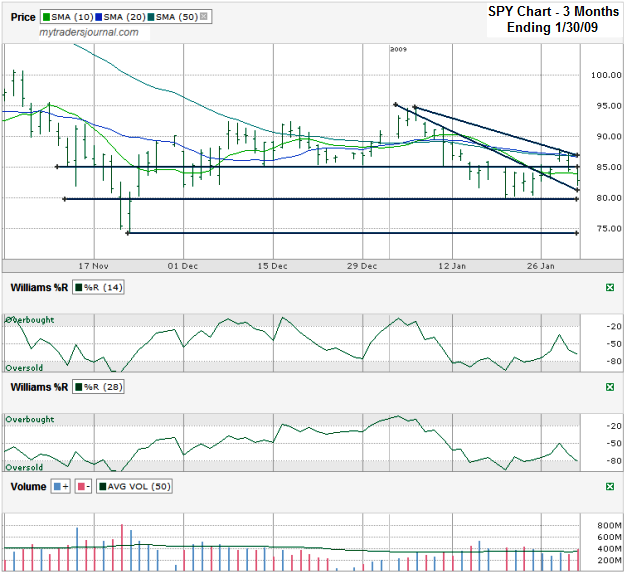The chart from January 23rd for the Dow Jones Industrial Average held true this past week to the trading channel I drew. It broke above the shorter trend line of lower highs, but couldn’t get outside of the much longer channel. Since that index charts the same this week I’m moving to the S&P 500, but instead of simply charting the $SPX.X I’m charting the tradable SPDR S&P 500 Depository Receipt (SPY). I’ve had a hard time finding any individual stock I feel comfortable investing in or even trading lately, so I started thinking about just working an index. SPY is always a fun one to work, so that’s why it gets the spotlight this weekend.
The short trend line I drew from the beginning of January through the middle of this week shows how the lower highs could continue. That line should coincide within another day or two with the trading channel SPY tried briefly to escape. The other trend line that was steeper just below it broke and then acted as support for new lower lows. That line is coinciding with the horizontal lower side of the trading channel I was just referencing. I still expect to test the lows of November, aka the lows of this bear market to date. If we can get a good test of the 75 range SPY could have a foundation to go up with more reliability. The issue with that is the d@mn fundamentals keep getting in the way.
This chart shows that we might be better off waiting for a better day to pick our trade. The price could tick in either direction in the near term and either way could be short lived. If anything, I might buy some longer term SPY puts and then sell lower strike nearer term puts. So far I don’t know what date and strike seems to be the best move. I’ll probably wait to see if 80 breaks for SPY and then make my trade. At least I want to wait until Williams %R and volume can lend some guidance.
The trouble is the same with it as the rest of the market. It’s as if companies are playing a game of hand slap. That’s the game where one person puts his hands palm to palm with the other one’s hands. The one on the bottom tries to slap the one on the top before he can move. If the top one moves before the bottom one attempts a slap he loses and the other player gets a free slap. If the one on top avoids a slap he wins and gets to be the slapper. The bottom one wins when he can land a slap, which allows him to remain as the slapper again. Companies seem to be trying to figure out who is going to be the last one to slap by laying-off employees and the first one to start increasing profits. If you go too soon you lose, unless you can strike pay dirt. Then you’re the hero. If you swing and miss you’re an idiot for mismanaging. I think most are choosing to take their chances with inaction, but ready to drop headcount whenever possible with the mindset that it’s better to flinch than get slapped with bigger losses.
A friend of mine in the staffing industry (at a previous employer of mine) just lost his job of 12 years. He got no severance. Just a pat on the back to say, “thanks for your dedication to us over the past 12 years, don’t forget to close the door behind you.” His company was slow to flinch, but sure did with a vengeance on Friday as they slashed their staff. My company hasn’t done it yet (mainly because my boss is inexperienced), but we all know it’s hard to keep a large staff of recruiters when we hire one person in a two week period when we averaged 10 hires per week just two to six months ago.

